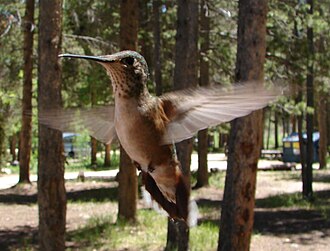Difference between revisions of "Field Guide/Birds/Archilochus colubris"
(→External links: adding link about 2007 spring migration) |
m (86 revision(s) from w:Ruby-throated Hummingbird) |
Revision as of 04:04, 22 March 2007
The Ruby-throated Hummingbird (Archilochus colubris), is a small hummingbird. It is the most common species of hummingbird that breeds in the eastern half of North America.
Description
The Ruby-Throated Hummingbird is 7-9 cm long with an 8-11 cm wingspan, and weighs 2-6 g. Adults are metallic green above and greyish white below, with near-black wings. Their bill is long, straight and very slender. The adult male, shown in the photo, has an iridescent ruby red throat patch which may appear black in some lighting, and a dark forked tail. The female has a dark rounded tail with white tips and generally no throat patch, though she may sometimes have a light or whitish throat patch. The male is smaller than the female, and has a slightly shorter beak. A moult of feathers occurs once per annum, and begins during the autumn migration.
Habitat
The breeding habitat is throughout most of eastern North America and the Canadian prairies, in deciduous and pine forests and forest edges, orchards, and gardens. The female builds a nest in a protected location in a shrub or tree.
The Ruby-throated Hummingbird is migratory, spending most of the winter in Mexico or Central America.
Behavior
Ruby-throated hummingbirds are solitary. Adults of this species typically only come into contact for the purpose of mating, and both males and females of any age aggressively defend feeding locations within his or her territory. The aggressiveness becomes most pronounced in late summer to early fall as they fatten up for migration. They feeding frequently while active during the day and when temperatures drop, particularly on cold nights, they may conserve energy by entering hypothermic torpor.
The birds feed on nectar from flowers and flowering trees using a long extendable tongue or catch insects on the wing. Due to their small size, they are vulnerable to insect-eating birds and animals. Females lay two white eggs averaging 12.9 by 8.5 millimeters (0.5 x 0.3 in).
References
- Template:IUCN2006 Database entry includes justification for why this species is of least concern
- Interesting Ruby-throated Hummingbird Facts donated by BirdHouses101.com
- http://www.rubythroat.org/RTHUExternalMain.html
- http://www.hummingbirds.net/rubythroated.html
External links
- Ruby-throated Hummingbird - Cornell Lab of Ornithology
- Ruby-throated Hummingbird Information - USGS Patuxent Bird Identification InfoCenter
- Ruby-throated Hummingbird Information and Photos - South Dakota Birds and Birding
- Ruby-throated hummingbird at feeder (animation)
- http://www.rubythroat.org - "Operation RubyThroat: The Hummingbird Project"
- http://www.hummingbirdsociety.org/photogallery - photographs of this and other hummingbird species
- All about the Ruby-throated Hummingbird
- How to Photograph Hummingbirds - including many photos of this species
- migration map (US and Canada only)
- 2007 spring migration
da:Rubinstrube de:Rubinkehlkolibri fr:Colibri à gorge rubis he:קוליברי אדום חזה מצוי nl:Robijnkeelkolibrie ja:ノドアカハチドリ tr:Kızıl sinek kuşu

